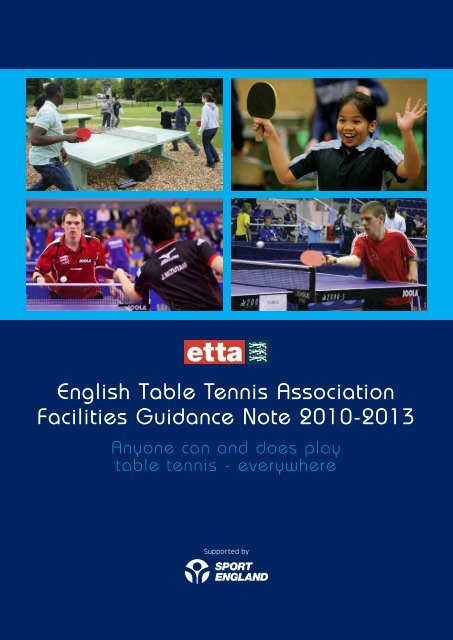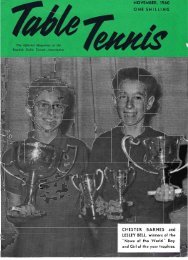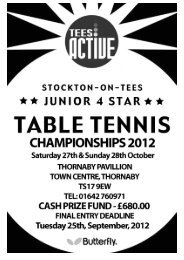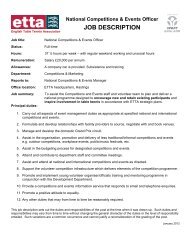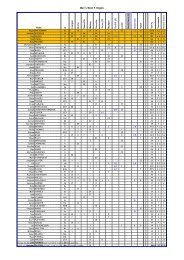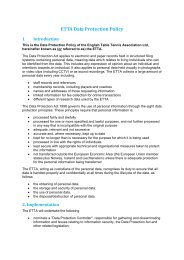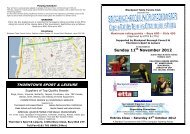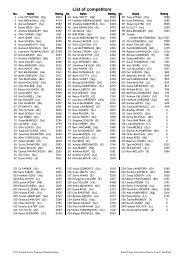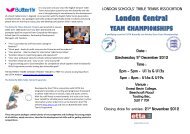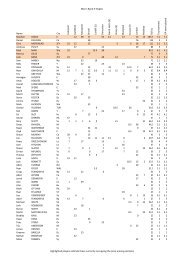English Table Tennis Association Facilities Guidance Note 2010-2013
English Table Tennis Association Facilities Guidance Note 2010-2013
English Table Tennis Association Facilities Guidance Note 2010-2013
- No tags were found...
You also want an ePaper? Increase the reach of your titles
YUMPU automatically turns print PDFs into web optimized ePapers that Google loves.
<strong>English</strong> <strong>Table</strong> <strong>Tennis</strong> <strong>Association</strong><br />
<strong>Facilities</strong> <strong>Guidance</strong> <strong>Note</strong> <strong>2010</strong>-<strong>2013</strong><br />
Anyone can and does play<br />
table tennis - everywhere<br />
Supported by
Contents<br />
1 Background 2<br />
1.1 Vision statement 3<br />
1.2 Introduction<br />
• Facility development<br />
• Innovation (outdoor <strong>Table</strong> <strong>Tennis</strong>, social<br />
media, workplace and youth clubs)<br />
1.3 Sport England strategic outcomes 3<br />
1.4 Strategy aims 3<br />
1.5 Current provision of facilities 4<br />
3<br />
2 What facilities are needed 6<br />
2.1 ETTA club development model 7<br />
2.2 Facility development options 8<br />
2.3 Model design briefs 9<br />
3 Why are these facilities needed 9<br />
3.1 Rationale 10<br />
3.2 Community Club Development Programme<br />
11<br />
research<br />
3.3 Sport England satisfaction survey research 11<br />
3.4 Achieving the Grow, Sustain & Excel outcomes<br />
– <strong>Table</strong> <strong>Tennis</strong> facility case studies<br />
12<br />
4 Where should facilities be located 17<br />
Acknowledgements<br />
This publication was commissioned by the<br />
ETTA <strong>Facilities</strong> Panel. Following consultation<br />
with the <strong>Table</strong> <strong>Tennis</strong> community in February<br />
<strong>2010</strong> it was endorsed by the panel in April and<br />
published in August <strong>2010</strong>.<br />
<strong>English</strong> <strong>Table</strong> <strong>Tennis</strong> <strong>Association</strong><br />
Queensbury House, Havelock Road, Hastings,<br />
East Sussex TN34 1HF<br />
T: 01424 722525<br />
www.etta.co.uk<br />
admin@etta.co.uk<br />
5 How could facilities be provided 17<br />
5.1 Funding for <strong>Table</strong> <strong>Tennis</strong> facilities 17<br />
5.2 Application process 18<br />
5.3 Application criteria 18<br />
5.4 Eligibility criteria 18<br />
5.5 Impact against Grow, Sustain and Excel 19<br />
5.6 Sustainability 19<br />
5.7 Ability to deliver 19<br />
5.8 Additionality 20<br />
5.9 ETTA decision making process 21<br />
6 When will facilities be provided 21<br />
7 National <strong>Table</strong> <strong>Tennis</strong> Centre 21<br />
8 Further information 21<br />
9 Appendices 21<br />
9.1 PremierClub summary 21<br />
9.2 Outdoor <strong>Table</strong> <strong>Tennis</strong> case study 22<br />
1
1 Background<br />
<strong>Table</strong> <strong>Tennis</strong> is one of the world’s most popular sports<br />
with over 300 million participants in more than 200<br />
countries affiliated to the International <strong>Table</strong> <strong>Tennis</strong><br />
Federation. The sport is played across the whole<br />
of England in a wide range of venues and with an<br />
improvement in facility provision it has the potential to<br />
grow and strengthen.<br />
The <strong>English</strong> <strong>Table</strong> <strong>Tennis</strong> <strong>Association</strong>’s Whole Sport Plan<br />
(2009-13) aims to increase the popularity of the sport,<br />
and improve how the sport is delivered in England.<br />
<strong>Table</strong> <strong>Tennis</strong><br />
Fun & enjoyable<br />
Whether recreational or competitive it appeals to and<br />
engages across all age groups, races, genders, classes<br />
and abilities.<br />
Olympic & Paralympic sport<br />
Fast, dynamic and highly competitive; table tennis is<br />
a special blend of mental agility, subtle tactics and<br />
explosive power.<br />
A sport for life<br />
Ages 5-80+, health and fitness benefits for body and<br />
mind leading to prolonged participation.<br />
Space efficient & versatile<br />
Four tables (up to 16 players) on a space equivalent<br />
to a badminton court. Can be played anywhere and<br />
everywhere (schools, workplace, community halls, sports<br />
clubs, etc).<br />
Easy to start<br />
<strong>Table</strong> <strong>Tennis</strong> is quick to learn and see tangible<br />
improvement.<br />
Helps to deliver government agendas<br />
National Indicator 8 (adult participation in sport and<br />
active recreation), National Indicator 6 (participation<br />
in regular volunteering), National Indicator 57 (children<br />
and young people’s participation in high quality PE and<br />
sport).<br />
2
1.1 Vision statement<br />
To develop opportunities for people to play <strong>Table</strong><br />
<strong>Tennis</strong> at all levels in accessible and high quality<br />
places, and to secure the long term future of the<br />
sport through facility ownership or long lease.<br />
ETTA will pilot four innovative projects:<br />
• Outdoor <strong>Table</strong> <strong>Tennis</strong> – participation opportunities<br />
in London parks and open spaces<br />
Outdoor <strong>Table</strong> <strong>Tennis</strong> helping deliver NI8 (increasing<br />
adult participation in sport and active recreation)<br />
Cippenham <strong>Table</strong> <strong>Tennis</strong> Club (Slough) social/refreshment<br />
area with visible connection to playing hall<br />
1.2 Introduction<br />
The ETTA facilities strategy makes the case for a<br />
comprehensive and cohesive framework for the<br />
development of sustainable facilities for the sport<br />
at national, regional, and local levels to support<br />
the delivery of <strong>Table</strong> <strong>Tennis</strong> across England. It has<br />
been developed through research and consultation<br />
throughout the ETTA by the <strong>Facilities</strong> Panel from a<br />
mandate by National Council, and it relates directly<br />
to the ETTA Whole Sport Plan 2009-13 facilities<br />
intervention.<br />
The strategy has the following two distinct strands:<br />
Facility development<br />
The strategy will build on previous capital investment<br />
to increase the quality and quantity of <strong>Table</strong> <strong>Tennis</strong><br />
facilities.<br />
Innovation<br />
To meet our strategic outcomes – Grow, Sustain and<br />
Excel - agreed with Sport England and the government<br />
we must innovate. Different facilities are needed in<br />
different areas to widen access and visibility of the<br />
sport.<br />
• Social media – e.g. creating participation<br />
opportunities in higher education.<br />
• Workplace – providing participation opportunities in<br />
the workplace.<br />
• Youth club – re-establishing lapsed traditional entry<br />
routes into the sport.<br />
1.3 Sport England strategic<br />
outcomes<br />
With limited capital funding available, the ETTA aims to<br />
work with clubs, leagues and external partners to make<br />
best use of the available resources, and ensure that<br />
ETTA funding is directed into projects that will have<br />
the largest impact on the three Sport England strategic<br />
outcomes of Grow, Sustain and Excel.<br />
1.4 Strategy aims<br />
The strategy aims to enable individuals and<br />
organisations to:<br />
1. Understand what facilities are required to enable the<br />
ETTA to deliver government objectives.<br />
2. Understand and support the prioritisation of<br />
investment to meet the needs of the sport through<br />
eligibility, deliverability (timing and ability to deliver<br />
strategic outcomes), sustainability (ability to operate<br />
effectively for years to come) and affordability<br />
(based on the levels of funding available from the<br />
ETTA and partnership funding sources).<br />
3. Prioritise future investments to ensure that the right<br />
facilities are developed in the right place at the right<br />
time to deliver the right outcomes for the ETTA.<br />
4. Obtain information on minimum standards of facility<br />
provision at all levels of the sport.<br />
3
The type of facilities required has a direct relationship<br />
to existing and future activities.<br />
This strategy details some examples of good practice<br />
and considers the following issues:<br />
• What facilities are needed<br />
• Why are these facilities needed<br />
• Where should facilities be located<br />
• How the facilities might be provided<br />
• When facilities are to be provided<br />
1.5 Current provision of facilities<br />
<strong>Table</strong> <strong>Tennis</strong> is, and can be, played in a wide variety of<br />
environments which is an advantage because it is easily<br />
set up but also a disadvantage as it is easily packed away<br />
therefore becoming invisible. Often the sport is made to<br />
put up with sub-standard facilities such as poor lighting,<br />
unsuitable floor covering or inappropriate wall colouring.<br />
<strong>Table</strong> <strong>Tennis</strong> facilities categorised by<br />
long lease or ownership.<br />
Current provision (<strong>2010</strong>) of <strong>Table</strong> <strong>Tennis</strong> facilities characterised by long lease or ownership<br />
Legend<br />
Legend<br />
ETTA Clubs <strong>2010</strong><br />
Facility type<br />
Type<br />
Long Lease<br />
Ownership<br />
Regions<br />
Northumberland<br />
Cumbria<br />
Durham<br />
Northfield<br />
TTC<br />
Ormesby<br />
TTC<br />
Barrow &<br />
District TT<br />
Centre<br />
North<br />
Yorkshire<br />
Scarborough TT<br />
PremierClub<br />
Halton<br />
TTC<br />
Shropshire<br />
Lancashire<br />
Preston<br />
TTC<br />
Cheshire<br />
Hilton<br />
TTC<br />
Woodfield<br />
TTC<br />
Abbeydale<br />
Park TTC<br />
Derbyshire<br />
Nottinghamshire<br />
Sycamore<br />
Draycott TTC<br />
& Long<br />
Eaton TTC<br />
Staffordshire<br />
Burton Uxbridge<br />
Leicestershire<br />
TTC<br />
Knighton<br />
Park<br />
TTC<br />
Wood Green HS TTC<br />
Colebridge<br />
TTC<br />
Worcestershire<br />
Keighley TT<br />
& Recreational Centre<br />
Hyndburn<br />
TTC<br />
Halifax<br />
Dewsbury<br />
TT Centre<br />
League TT<br />
Centre<br />
Great<br />
Wyrley TTC<br />
Warwickshire<br />
Northamptonshire<br />
Scunthorpe<br />
Sports Club<br />
Westfield<br />
TTC<br />
Milton Keynes<br />
TTC Bedfordshire<br />
Hull<br />
YPI TTC<br />
Lincolnshire<br />
Clee Fields<br />
sports hall<br />
Cambridgeshire<br />
St Neots<br />
TTC<br />
King’s<br />
Lynn TT<br />
Centre Norfolk<br />
Suffolk<br />
Ilfracombe<br />
TTC<br />
Gloucestershire<br />
Wiltshire<br />
Kidlington<br />
Forum TTC<br />
Buckinghamshire<br />
Oxfordshire<br />
Cippenham<br />
TTC<br />
Kingfisher<br />
TTC<br />
Ashford<br />
TTC<br />
Surrey<br />
Hitchen TT Centre<br />
Hertfordshire<br />
Barnet BATTS Essex<br />
TT Centre<br />
Ltd. Ellenborough<br />
TTC<br />
Greater London Authority<br />
Graham<br />
Spicer<br />
TTC<br />
Howard<br />
TTC<br />
Kent<br />
Somerset<br />
Hampshire<br />
Okehampton<br />
TTC<br />
Devon<br />
Dorset<br />
Bournemouth Sports Club<br />
Waterside<br />
TTC<br />
Generation<br />
2 TTC<br />
West<br />
Sussex<br />
Portsmouth<br />
TTC<br />
East<br />
Sussex<br />
Carl Prean<br />
Centre, Isle<br />
of Wight<br />
Cornwall<br />
St Austell<br />
TTC<br />
Isles of Scilly<br />
4<br />
© Crown copyright. All rights reserved<br />
Sport England 100033111 <strong>2010</strong>.<br />
Sport England, Victoria House,<br />
Bloomsbury Square, London, WC1B 4SE<br />
Tel: 020 7273 1514<br />
Email: mark.critchley@sportengland.org<br />
Drawn by: Mark Critchley<br />
Reference: 0080MC<br />
Date: 30th April <strong>2010</strong><br />
Version: 2 (Final)
Keighley <strong>Table</strong> <strong>Tennis</strong> Club open evening demonstration<br />
The table below illustrates the variety of environments where <strong>Table</strong> <strong>Tennis</strong> is played.<br />
Local authority<br />
(sports/leisure centres,<br />
community centres)<br />
Schools<br />
Workplace venues<br />
Higher and further<br />
education<br />
Outdoors<br />
Home<br />
Holiday parks and<br />
camp sites<br />
Some clubs share facilities with other sports (such as other sports hall based sports),<br />
rarely as part of the same organisation, but as a stand-alone club with a separate<br />
committee. A lack of security of tenure or a robust community use agreement places<br />
uncertainty and pressure on clubs. Investment into these sites can ensure longer<br />
terms of tenure and better security for the club.<br />
Often short term (three years) school-club agreements with limited long term<br />
security of tenure. Club based and/or school delivered after school activity is<br />
common throughout the country. Provision within this sector may be significantly<br />
enhanced through the Building Schools for the Future programme where outdoor<br />
table tennis tables are encouraged as part of a core outdoor/playground<br />
specification.<br />
Formerly one of the most popular locations for league team <strong>Table</strong> <strong>Tennis</strong> though<br />
restrictive for other activities. Workplace venues have declined in parallel to the<br />
decline of the manufacturing industry, increased building security and loss of social<br />
areas. An ETTA ‘workplace’ whole sport plan intervention will aim to address this.<br />
Either as part of a formal student run club or in a social capacity, <strong>Table</strong> <strong>Tennis</strong> is<br />
played within HE and FE venues.<br />
An ideal entry level to <strong>Table</strong> <strong>Tennis</strong> within the local community, there is an increasing<br />
number of outdoor tables in use in England particularly on school sites. Provision in<br />
parks and open spaces is under way with a pilot project in London. Outdoor <strong>Table</strong><br />
<strong>Tennis</strong> is very popular and visible on the continent.<br />
The sport is an ideal activity for domestic homes particularly with the availability of<br />
mini and midi size tables. Garages, play rooms, basements and gardens are commonly<br />
used recreationally.<br />
Widely played and enjoyed as a casual/recreational activity although in the past it<br />
has been a well known, organised activity (competition and coaching) at Butlins and<br />
Pontins holiday parks.<br />
The Central Council of Physical Recreation (CCPR) survey of sports clubs 2009 indicates that 67% of <strong>Table</strong> <strong>Tennis</strong><br />
clubs hire a facility, only 9% own a facility and 21% lease a facility. It could be concluded from this that two thirds of<br />
<strong>Table</strong> <strong>Tennis</strong> clubs hire facilities, have limited control and therefore uncertainty about their future.<br />
5
2 What facilities are needed<br />
Facility requirements are driven by clubs and the people<br />
that operate within them. <strong>Table</strong> <strong>Tennis</strong> needs improved<br />
access to improved facilities with a corresponding<br />
increase in the number and quality of people to deliver<br />
the sport.<br />
and talent development spanning all three Grow, Sustain<br />
and Excel outcomes. Typically PremierClubs should<br />
have a varied playing programme with good multi-table<br />
facility access and a volunteer base that allows for<br />
development, growth and sustainability.<br />
PremierClub ‘Ability’ is part of PremierClub and is<br />
designed to provide opportunities for disabled players<br />
and to provide disability awareness training within clubs.<br />
Ellenborough <strong>Table</strong> <strong>Tennis</strong> Club (Enfield) bar/servery<br />
Ellenborough <strong>Table</strong> <strong>Tennis</strong> Club - social area with a<br />
visible connection to playing hall<br />
Within its Whole Sport Plan 2009-13, the ETTA has<br />
identified a desire to develop specialist facilities for<br />
local, regional and national level use principally guided<br />
by PremierClub - the ETTA national programme for<br />
club development. PremierClub is directly aligned to<br />
CLUBMARK – the Sport England national cross sport<br />
accreditation scheme.<br />
PremierClub provides a framework for club development<br />
leading to participation/membership growth, volunteer<br />
Club development is significantly enhanced where<br />
a social/meeting/refreshment area has a visible<br />
connection to the playing hall.<br />
The development of a variety of types of facilities<br />
can make a difference and contribute to achieving the<br />
strategic outcomes (2009-13 <strong>Table</strong> <strong>Tennis</strong> grow target<br />
= 16,000 adults (16+) playing more <strong>Table</strong> <strong>Tennis</strong>). To<br />
assist the achievement of this target the development<br />
of appropriate facilities is critical. The PremierClub<br />
Information & Criteria leaflet details requirements for<br />
people, places and programmes at each PremierClub<br />
level, see Appendix 9.1.<br />
<strong>English</strong> Open, Sheffield 2009, early morning set-up<br />
6
2.1 <strong>English</strong> <strong>Table</strong> <strong>Tennis</strong> <strong>Association</strong> Club Development Model<br />
The diagram below illustrates the ETTA club development model and demonstrates the connection between the<br />
two strategy strands - facility development and innovation.<br />
ETTA<br />
National<br />
Centre<br />
Excel<br />
10<br />
Regional<br />
Performance Clubs<br />
based in<br />
PremierClub (Excellence)<br />
PremierClub (Excellence)<br />
PremierClub (Advanced)<br />
PremierClub (Participation)<br />
Premier Clubmark Clubs<br />
<strong>Table</strong> <strong>Tennis</strong> Clubs (non PremierClubs)<br />
Grow, Sustain & Excel<br />
Grow & Sustain<br />
ETTA Whole Sport Plan 2009-13 outcomes<br />
Entry routes into ‘organised’ table tennis<br />
(schools, youth clubs, community centres, holiday centres)<br />
Grow<br />
‘Grow’ innovation pilot projects<br />
(outdoor table tennis, social media, workplace, youth clubs)<br />
7
Disabled squad training in Northern General Hospital, Sheffield<br />
2.2 Facility development options<br />
Experience and research from previous projects<br />
demonstrates that there are four main options <strong>Table</strong><br />
<strong>Tennis</strong> facility development can take - each one can have<br />
an impact on participation, satisfaction of members and<br />
talent development. Historically, <strong>Table</strong> <strong>Tennis</strong> has been a<br />
‘parasitic’ sport utilising other (often under used) sports<br />
facilities. Provided that technical specifications are<br />
adhered to, this can be a very cost effective method of<br />
provision.<br />
Halton <strong>Table</strong> <strong>Tennis</strong> Club (Runcorn, Cheshire)<br />
table configuration for British League matches<br />
The four main types of facility development options are:<br />
1) Upgrade – equipment, lighting, flooring, heating/<br />
ventilation, social/refreshment/storage areas,<br />
changing, and security of tenure<br />
(small – moderate ETTA investment up to £30,000<br />
– minimum five year security of tenure)<br />
3) Bolt on – new playing hall ‘bolted on’ to an<br />
existing facility and sharing existing ancillary<br />
facilities with long lease<br />
(moderate – large ETTA investment £30,000 –<br />
£150,000)<br />
2) Conversion – change of use of an existing building<br />
to meet table tennis playing hall and ancillary<br />
facilities specifications, and to achieve long lease<br />
(21+ years) or preferably freehold<br />
(moderate – large ETTA investment £30,000 –<br />
£150,000)<br />
4) Stand alone/new build – purpose built to <strong>Table</strong><br />
<strong>Tennis</strong> specifications with long lease (21+ years)<br />
or preferably freehold<br />
(large ETTA investment £150,000+)<br />
NB. Investment figures are an approximate guide only<br />
8
2.3 Model design briefs<br />
Model table tennis facility design – illustrating critical factor of visible connection between social/meeting area and<br />
playing hall.<br />
These briefs are indicative only. Figures given are not intended to be either the minimum or maximum required but rather<br />
a starting point for each scheme to identify its priorities and define its needs in detail. All schemes will have to meet<br />
statutory requirements, which will vary from scheme to scheme and may differ from figures shown above, as well as design<br />
standards for playing court sizes, flooring, lighting, etc<br />
4 table centre 6 table centre 9 table centre <strong>Note</strong>s<br />
Playing area: 4 tables at Grade 3 (or 6<br />
for practice at Grade 4<br />
or 2 at grade 2)<br />
Minimum area 22m x<br />
12m<br />
Toilets: Male: 1 wc + 2 urinals +<br />
1 basin<br />
Female: 2 wcs + 1 basin<br />
Disabled: 1 standard<br />
cubicle*<br />
Changing**: Male: 15 changing + 3<br />
showers<br />
Female: 15 changing + 3<br />
showers<br />
Disabled: 1 changing and<br />
shower cubicle*<br />
6 tables at Grade 3 (or<br />
9 for practice or 3 at<br />
grade 2)<br />
Minimum area 22m x<br />
18m or 32m x 12m<br />
Male: 2 wcs + 3 urinals +<br />
2 basins<br />
Female: 3 wcs + 2 basins<br />
Disabled: 1 standard<br />
cubicle*<br />
Male: 20 changing + 5<br />
showers<br />
Female: 20 changing + 5<br />
showers<br />
Disabled: 1 changing and<br />
shower cubicle*<br />
9 tables at Grade 3<br />
(or 16 for practice or 5<br />
at Grade 2)<br />
Based on 33m x 18m<br />
(standard ‘4 court’<br />
sports hall)<br />
Male: 2 wcs + 4 urinals +<br />
3 basins<br />
Female: 3 wcs + 2 basins<br />
Disabled: 2 standard<br />
cubicles*<br />
Male: 32 changing + 8<br />
showers<br />
Female: 32 changing + 8<br />
showers<br />
Disabled: 2 changing and<br />
shower cubicles*<br />
Entrance area: 10m² 15m² 30m²<br />
Reception: 5m² 5m² 10m², access to office<br />
Office/event<br />
management room<br />
5m² 5m² 10m²<br />
* Subject to local<br />
authority requirements.<br />
Disabled toilet and<br />
changing provision<br />
could be combined<br />
** The number of<br />
changing spaces shown<br />
are likely to be the<br />
maximum required<br />
for table tennis use<br />
alone and analysis of<br />
anticipated demand may<br />
support a reduction.<br />
Equipment store: 10m² 20m² 30m²<br />
Social area: 30m² 40m² 60m²<br />
Meeting room: 10m² - could be divisible 15m² - could be divisible 20m²<br />
part of social area part of social area<br />
Kitchen:<br />
5m² with servery to<br />
social area<br />
10m² with servery to<br />
social area<br />
15m² with servery to<br />
social area<br />
First aid: First aid box in office First aid box in office First aid box in office<br />
Cleaner’s store: With bucket sink With bucket sink With bucket sink<br />
Car parking: 15 spaces, including 2<br />
disabled bays<br />
Design<br />
considerations:<br />
35 spaces, including 4<br />
disabled bays and 20<br />
overflow spaces<br />
Bar serving into social area (could be combined with kitchen).<br />
Additional storage to kitchen/bar and general areas.<br />
Additional capacity: toilets, changing, social area, parking, etc<br />
40 spaces, including 5<br />
disabled bays and 30<br />
overflow spaces<br />
Subject to local<br />
authority requirements<br />
3 Why are these facilities needed<br />
There is a current lack of suitable <strong>Table</strong> <strong>Tennis</strong> venues.<br />
Over a 30 year period the table tennis venue<br />
infrastructure has drastically reduced in capacity and<br />
the majority of venues had and still have lack of space<br />
(only one table), lack of ancillary areas (meeting/social,<br />
refreshments, office, changing rooms, showers, toilets,<br />
etc), limited availability and limited or lack of security<br />
of tenure.<br />
67% of clubs hire their facility and therefore do not<br />
have control over it; this can restrict the potential to<br />
grow participation and increase levels of satisfaction<br />
for players and volunteers.<br />
9
3.1 Rationale - facilities and playing<br />
environments<br />
Clearly to enable a wider range of <strong>Table</strong> <strong>Tennis</strong> activity<br />
and to improve levels of participant satisfaction in<br />
an increasingly competitive leisure market place, high<br />
quality venues are needed offering multi-table playing<br />
areas, social and ancillary facilities, good access and<br />
crucially longer term security of tenure.<br />
Ormesby <strong>Table</strong> <strong>Tennis</strong> Club (Middlesbrough)<br />
3.2 Community Club Development<br />
Programme (CCDP) objectives<br />
• To assist in creating a sustainable and financially<br />
viable sports club infrastructure in England that<br />
links with schools, provides appropriate support and<br />
pathways for identifying and developing talented<br />
individuals, and meets the needs of communities<br />
• To increase club membership levels and to support<br />
the development of quality assured ‘junior’ sections<br />
• To increase club membership among women, black<br />
and other ethnic groups and people with disabilities<br />
Paul Drinkhall, England international<br />
from Ormesby <strong>Table</strong> <strong>Tennis</strong> Club<br />
CCDP research<br />
Analysis of project evaluation returns (2009) of <strong>Table</strong><br />
<strong>Tennis</strong> facilities funded through the Community Club<br />
Development Programme clearly demonstrates that<br />
facility investment delivers significant growth of<br />
participants, members and volunteers. These increases<br />
are due to improvements to playing areas, ancillary<br />
facilities such as refreshment and social areas, offices<br />
and changing.<br />
Ormesby <strong>Table</strong> <strong>Tennis</strong> Club club night & elite training<br />
Ormesby <strong>Table</strong> <strong>Tennis</strong> Club school session<br />
Ormesby <strong>Table</strong> <strong>Tennis</strong> Club fitness room<br />
10
Community Club Development Programme 2003-08 Research<br />
Before CCDP After CCDP Increase % increase<br />
Total active members 640 906 266 42%<br />
Female active members 123 160 37 30%<br />
Male active members 552 746 194 35%<br />
Active members 0-15 202 311 109 54%<br />
Active members 16+ 436 664 228 52%<br />
Disabled active members 27 41 14 52%<br />
Black & Minority Ethnic groups (BME) active members 104 131 27 26%<br />
Socially disadvantaged members 56 128 72 129%<br />
Total participants 2,730 5,815 3,085 113%<br />
Female participants 643 1,502 859 134%<br />
Male participants 2,087 4,313 2,226 107%<br />
Participants 0-15 1,080 2,541 1,461 135%<br />
Participants 16+ 1,660 3,270 1,610 97%<br />
Disabled participants 119 290 171 144%<br />
BME participants 574 973 399 70%<br />
Socially disadvantaged members 155 870 715 461%<br />
Total volunteers 121 167 46 38%<br />
Female volunteers 22 39 17 77%<br />
Male volunteers 99 128 29 29%<br />
Volunteers 0-15 4 5 1 25%<br />
CCDP partnership funding<br />
Of the total project costs (£4,876,000) 40% partnership<br />
funding was achieved.<br />
Burton/Uxbridge <strong>Table</strong> <strong>Tennis</strong> Club (Staffordshire) -<br />
14 table school tournament set up<br />
3.3 Sport England satisfaction<br />
survey reseach<br />
Sport England strategy 2008-11 stated that a key<br />
outcome will be increasing participation in NGBaccredited<br />
clubs to a third of all 5-16 year olds by <strong>2010</strong><br />
– the development of specialist <strong>Table</strong> <strong>Tennis</strong> facilities<br />
will assist this.<br />
The Sport England satisfaction with the quality of<br />
the sporting experience survey (SQSE) suggests that<br />
sustaining levels of participation is directly related to<br />
levels of enjoyment which in turn is impacted by the<br />
quality of sporting experience. Survey results published<br />
in July 2009 provide specific <strong>Table</strong> <strong>Tennis</strong> data on what<br />
is important to people when they play <strong>Table</strong> <strong>Tennis</strong><br />
and opinions of their current quality of <strong>Table</strong> <strong>Tennis</strong><br />
experience.<br />
11
To measure ‘satisfaction’, survey respondents<br />
(participant/club member/talent pool) scored a series<br />
of questions within ten domains. <strong>Facilities</strong> and playing<br />
environment is one such domain.<br />
Relative importance of and satisfaction<br />
with table tennis facilities and playing<br />
environment (SQSE July 2009)<br />
Scoring 1-10 (1 = low) Importance Satisfaction<br />
General participants 7.8 7.6<br />
Affiliated club members 8.2 7.4<br />
Talent pool 8 7.1<br />
The SQSE survey showed the attributes that have the<br />
highest impact on overall satisfaction for <strong>Table</strong> <strong>Tennis</strong><br />
players are:<br />
• The quality of equipment = tables, nets, surrounds<br />
• The quality of the surfaces = floor<br />
• The quality of lighting = lights<br />
• The heating and ventilation = don’t like cold venues!<br />
• The quality of the non-sport facilities = social,<br />
changing, catering, parking<br />
The availability of high quality child care facilities has a<br />
medium impact on overall satisfaction.<br />
Ease of participation<br />
The SQSE survey showed the attributes that have the<br />
highest impact on overall satisfaction for <strong>Table</strong> <strong>Tennis</strong><br />
players are:<br />
• Being able to take part without being interrupted or<br />
disturbed by members of the public<br />
• Being able to take part at places that were not<br />
overcrowded<br />
• Time it took me to get to the places where I play<br />
• Being able to participate/compete at a time that<br />
was convenient to me<br />
• The ease with which I could balance my sporting,<br />
work, family or education commitments<br />
• The ease of making a booking when I participated<br />
• The commitment and punctuality of other people<br />
within <strong>Table</strong> <strong>Tennis</strong><br />
These findings indicate that investment in facilities<br />
for table tennis can make a big difference to overall<br />
satisfaction of <strong>Table</strong> <strong>Tennis</strong> players.<br />
In addition, the provision of more facilities for <strong>Table</strong><br />
<strong>Tennis</strong> will create additional sustainable, playing<br />
opportunities that will contribute to the Grow, Sustain<br />
and Excel outcomes.<br />
These findings indicate that investment in<br />
refurbishment/improvement grants for lighting,<br />
flooring, heating and ancillary facilities will make a big<br />
difference to overall satisfaction of <strong>Table</strong> <strong>Tennis</strong> players.<br />
Joanna Parker, England international<br />
3.4 Achieving the Grow, Sustain &<br />
Excel outcomes - <strong>Table</strong> <strong>Tennis</strong><br />
facility case studies<br />
Ellenborough <strong>Table</strong> <strong>Tennis</strong> Club -<br />
view from social area into playing hall<br />
The following case studies are provided as model<br />
examples of how clubs have successfully developed their<br />
facilities and the impact that this has had on provision.<br />
They aim to help potential schemes make the case for<br />
projects by demonstrating the impact projects of all<br />
scales have had on delivering increased participation.<br />
12
<strong>Table</strong> <strong>Tennis</strong> facility case study<br />
Facility Type: Upgrade/conversion<br />
Club Name: Haworth Hawks TTC<br />
Website: www.keighleytabletennis.co.uk<br />
Location: Keighley, Yorkshire<br />
What did the club do<br />
• Formed in a community centre in 2007 with support<br />
from a £6,460 lottery grant from Awards for All.<br />
• Reached saturation in spring 2009 with 60 members.<br />
• Identified Keighley Business Centre (formerly a<br />
textile mill) as a possible new home.<br />
• Set up a community interest company (Keighley<br />
TTC) and achieved Key Fund Yorkshire grant/<br />
loan support package to take out 15 year lease of<br />
second floor totalling 9,000ft.<br />
• Achieved CLUBMARK.<br />
• Refurbished derelict mill in 2009 – clearing out,<br />
plastering, painting, re-wiring, etc. into an 8 table<br />
competition (15 table coaching) venue with social<br />
area, toilets and changing.<br />
• Although Keighley TTC is a separate entity to<br />
Haworth Hawks TTC it is the club home.<br />
How much did it cost (2009)<br />
• £20,000 (labour costs kept to a minimum through<br />
volunteer effort and dedication).<br />
What difference did it make to the club<br />
• Put the club on a sound financial footing by<br />
developing income streams from catering,<br />
refreshments and sub-letting of space to other<br />
community groups.<br />
• Made the club more accessible being located close<br />
to the town centre and transport links.<br />
• Allowed the club to massively expand.<br />
• Unrestricted 24/7 access allows members access<br />
to comfortable lounge area, bar and toilets.<br />
How did the investment contribute to the ETTA and<br />
Sport England strategic outcomes<br />
• Grow – instant membership growth from 60–75<br />
(including 7 teams in Keighley & District League).<br />
• Sustain – refurbished playing hall and social/<br />
refreshment area has had a positive effect on<br />
player and spectator visits.<br />
• Excel – though not an initial priority, player<br />
pathways and talent development will be a natural<br />
progression of having access to facilities 24/7.<br />
‘Take a look at what the centre really looks like by<br />
going on YouTube under Keighley <strong>Table</strong> <strong>Tennis</strong> Centre’.<br />
13
<strong>Table</strong> <strong>Tennis</strong> facility case study<br />
Facility Type: Conversion<br />
Club Name: BATTS<br />
Website: www.batts.org.uk<br />
Location: Harlow, Essex<br />
What did the club do<br />
• Bid for and secured 25 year lease for a<br />
redundant, loss making local authority recreation<br />
building (Norman Booth Centre) in 2006.<br />
• Achieved Community Club Development funding<br />
(CCDP) from Sport England via ETTA.<br />
• Converted and refurbished the centre to <strong>Table</strong><br />
<strong>Tennis</strong> specifications (12 court playing hall with<br />
new semi-sprung floor, social area with viewing<br />
gallery into the playing hall, disability access<br />
including a lift, fully fitted kitchen, changing,<br />
office and storage).<br />
• Appointed a full-time Regional Disability, Club<br />
Support & Coaching Officer in conjunction with<br />
ETTA and Mark Hall School Sports Partnership.<br />
• Advertised the premises and secured bookings to<br />
hire out the facility to local community groups.<br />
How much did it cost (2007)<br />
• £212,000 (Sport England Community Club<br />
Development Fund £110k; Essex Community.<br />
Initiative Fund 40k, and Harlow Recreation Trust<br />
62k).<br />
What difference did it make to the club<br />
• Secured the long term future of the club by<br />
putting it on a sound financial footing through<br />
sub-letting policy to include <strong>Table</strong> <strong>Tennis</strong> and<br />
other sporting activities.<br />
• New and additional facilities have made the<br />
club feel like a true ‘club’ in the sense that<br />
members and participants have a high quality<br />
and welcoming environment (evidenced through<br />
retention of existing and increase of new<br />
members and new participants, popularity/sales<br />
of refreshments).<br />
“This has been one of the most significant<br />
impacts. Feedback has been amazingly positive<br />
especially when you consider the club’s lack of<br />
experience in contributing to a major building<br />
project. Some fine partners (notably Paul Baker<br />
at the ETTA) ensured that the final outcome<br />
was just about spot on in terms of customer<br />
satisfaction! To understand this fully, one has<br />
to contrast the bright new changing rooms,<br />
gleaming kitchen and open plan social area with<br />
the dank, dirty, claustrophobic facilities that<br />
had seen no investment for 25 years. On the<br />
playing area a new floor, lighting and tables has<br />
made BATTS the venue of choice for hosting a<br />
huge array of local, county, regional and national<br />
events.” Neil Brierley, BATTS Secretary.<br />
14
• Expanded the club playing programme to include<br />
beginner/schools coaching, regional performance<br />
training, grass roots and high level competitions.<br />
• Attracted more helpers/volunteers (50% increase<br />
from 8 to 12) and put in place a strategy to<br />
strengthen the club volunteer infrastructure.<br />
• Increased the club profile in the local community<br />
and beyond through club success (club of the<br />
year, Harlow, Essex, East region) and up to 35<br />
lettings to local groups per week.<br />
How did the investment contribute to the ETTA and<br />
Sport England strategic outcomes<br />
• Grow – 15% increase of <strong>Table</strong> <strong>Tennis</strong> participants<br />
to date from 228 to 255. Although primarily<br />
designed for <strong>Table</strong> <strong>Tennis</strong>, the club facilities<br />
provide a venue for six other sports including<br />
martial arts, football, badminton, short mat<br />
bowls, volleyball, dance, sailing clubs and even<br />
children’s birthday parties, driving around 450<br />
people through the centre in a typical week.<br />
• Sustain – improved facilities that have led<br />
to increased levels of player and volunteer<br />
satisfaction.<br />
“The clean, modern and welcoming atmosphere<br />
of the new venue with its large voluntary run<br />
cafeteria and open plan social area means we<br />
retain and attract groups through word of mouth<br />
and through a large local publicity effort.” Neil<br />
Brierley, BATTS Secretary<br />
• Excel – the club is able to deliver a progressive<br />
coaching programme and player pathway from<br />
beginners through to regional training. With a fulltime<br />
Regional Disability, Club Support & Coaching<br />
Officer in post at the time of writing the club<br />
expects 1) a stream of young people to come<br />
through from the local schools, 2) new adult<br />
and junior disability sessions, 3) to draw in adult<br />
players from the county and also parts of east<br />
London.<br />
Anyone can and does play table tennis - everywhere<br />
15
<strong>Table</strong> <strong>Tennis</strong> facility case study<br />
What difference did it make to the club<br />
Facility Type: Bolt on/new build<br />
Club Name: Cippenham TTC<br />
Website: www.cippenhamttc.co.uk<br />
Location: Slough, Buckinghamshire<br />
What did the club do<br />
• Achieved funding for a purpose built, nine court<br />
competition (15 for coaching) <strong>Table</strong> <strong>Tennis</strong> centre<br />
with a 60 year lease on Westgate School site<br />
(grant maintained).<br />
• Moved in 1996 from a two night a week + Sunday<br />
coaching at Haymill Community Centre to a five<br />
night a week + weekend large scale club with 231<br />
members (2009).<br />
• Set up Cippenham <strong>Table</strong> <strong>Tennis</strong> Centre Ltd to run<br />
the building and safeguard Cippenham TTC which<br />
runs the activities.<br />
How much did it cost (1995)<br />
• £520,000 (Lottery sports fund £277,000,<br />
Funding Agency for Schools £105,000, Sports<br />
Council £30,000, Slough Borough Council £8,000,<br />
Westgate School £20,000, ETTA (Foundation<br />
for Sports & the Arts) £70,000, Cippenham TTC<br />
£10,000).<br />
• Enabled the club to fulfil its ambitions to grow<br />
its members and activities achieved through<br />
improved access to a large, good quality playing<br />
hall and ancillary facilities allowing expansion of<br />
coaching and competition programmes.<br />
• Allowed the club to generate income from<br />
membership and playing fees, tournament entry<br />
fees, external hiring and catering. The club is on<br />
an exceptionally sound financial footing.<br />
• Provides 35 volunteers with a more worthwhile<br />
experience and satisfaction of running the club.<br />
• The club lounge (social area) and servery provides<br />
a comfortable and welcoming environment with<br />
refreshments and some child care provision that<br />
has improved the satisfaction of the <strong>Table</strong> <strong>Tennis</strong><br />
experience for all club visitors (players, officials,<br />
spectators, parents).<br />
• The club has a high profile and excellent<br />
reputation for running local, county, regional and<br />
national competitive opportunities and volunteer<br />
training.<br />
How did the investment contribute to the ETTA and<br />
Sport England strategic outcomes<br />
• Grow – participant throughput has grown from<br />
approximately 2,000 in 1996 to approximately<br />
7,500 in 2009. Upon relocation to the new centre,<br />
club membership immediately increased from<br />
60 to 153 and currently (<strong>2010</strong>) stands at 231<br />
(throughput of 100 player visits per week).<br />
• Sustain – the design of the facilities has been<br />
crucial to improving the quality of the Cippenham<br />
<strong>Table</strong> <strong>Tennis</strong> experience and player satisfaction<br />
- the visible connection between the lounge and<br />
playing hall being fundamental here in creating a<br />
‘club atmosphere’ where sport and social meet.<br />
• Excel – the club provides the facilities,<br />
competition, coaching and support that enables<br />
talent development, evidenced through the<br />
current playing programme and production of 14<br />
‘home grown’ national champions since moving to<br />
the table tennis centre. Additionly two players have<br />
won Commonwealth, European and World titles.<br />
16
sport and active recreation), show evidence of a need -<br />
latent demand or market segmentation (Active People<br />
data) AND significantly demonstrate that the volunteer<br />
infrastructure is in place to sustain the proposed facility.<br />
The ETTA regional club & facility project registers<br />
devised in 2008 by Regional Development Officers have<br />
identified up to 100 potential facility projects. Registers<br />
can be regularly updated and for projects to be<br />
considered the project team must work with the ETTA<br />
Regional Development Managers to develop their project<br />
in line with the application process.<br />
ETTA has a long term aspiration to create at least<br />
one <strong>Table</strong> <strong>Tennis</strong> facility capable of operating at<br />
PremierClub – Excellence level (minimum 24 hours<br />
per week, 40 weeks of the year) in each local<br />
authority area.<br />
Shop-ping Pong!<br />
4 Where should facilities be located<br />
<strong>Table</strong> <strong>Tennis</strong> is played nationwide and facility<br />
development can be justified across the country.<br />
However the ETTA Whole Sport Plan identified a London<br />
focus for Sport England investment to develop projects<br />
that will capitalise on London 2012 legacy and interest<br />
generated in schools through Greenhouse* that fill a gap<br />
of facility provision in the capital city.<br />
*Greenhouse helps young people living in deprived<br />
communities develop positive life skills through sport<br />
and performing arts. They target those who may<br />
not otherwise have access to these opportunities,<br />
working in state secondary schools, special schools and<br />
community clubs. More than 5,000 young people every<br />
week develop life skills through <strong>Table</strong> <strong>Tennis</strong> in schools<br />
and community clubs across London and Wales.<br />
In addition to London, ETTA will consider applications<br />
from other areas that can help deliver local area<br />
agreements (in particular NI 8 adult participation in<br />
Ellenborough <strong>Table</strong> <strong>Tennis</strong> Club<br />
ETTA is particularly keen to develop <strong>Table</strong> <strong>Tennis</strong><br />
facilities on school sites and utilise under used/<br />
redundant buildings.<br />
5 How could facilities be provided<br />
5.1 Funding for <strong>Table</strong> <strong>Tennis</strong> facilities<br />
The ETTA has a capital facilities allocation available<br />
of £2m to cover the period 2009-13. There is a<br />
commitment with Sport England that ETTA capital<br />
investment must deliver partnership funding at least<br />
pound for pound which could come from a number<br />
of different national and local sources including the<br />
following: Building Schools for the Future, county<br />
councils, local authorities, schools, local sources of<br />
funding and club funds.<br />
17
Park ping pong on permanent table in Charlton Park, Greenwich, London<br />
(notice outdoor gym with wifi in background)<br />
5.2 Application process<br />
Applications for funding will open in late <strong>2010</strong> and each<br />
project should be able to satisfy the following prior to<br />
applying to ETTA for funding:<br />
• Can the project demonstrate a local/regional/<br />
national strategic need<br />
• Is the project working with the ETTA Regional<br />
Development Manager<br />
• Is the local authority aware of and involved in the<br />
project<br />
• Is the project working with any other youth and<br />
community groups or sports<br />
• Is the project an accredited PremierClub<br />
• Can the project provide an adequate level of<br />
partnership funding<br />
• Can the project demonstrate the ability to deliver<br />
within a limited timescale<br />
Projects must demonstrate a robust ‘needs and<br />
evidence’ base which underpins the project,<br />
demonstrate strong partnerships which will last beyond<br />
the initial development of the project, and thereby<br />
contributing to the long term sustainability of the<br />
project.<br />
5.3 Application criteria for ETTA<br />
financial support<br />
ETTA anticipates receiving more applications for<br />
projects that it is able to fund. Bids will be competitive<br />
and will be assessed using two sets of criteria: 1)<br />
eligibility 2) impact against outcomes, sustainability,<br />
deliverability and additionality.<br />
5.4 Eligibility criteria<br />
Applicants will need to demonstrate they meet the<br />
following criteria to be eligible for ETTA Whole Sport<br />
Plan capital funding:<br />
• Applicant organisation must be entitled to receive<br />
public funding, e.g. sports club, voluntary or<br />
community organisation, local authority and<br />
education establishment such as school, college and<br />
university.<br />
• Project benefits all sections of the local community.<br />
• Request funding for the development of capital<br />
infrastructure, which can be taken to contribute<br />
to the costs of new build, conversion, bolt on,<br />
upgrades (where not previously in receipt of<br />
government funding) and major fixed equipment<br />
where it is an integral part of a project.<br />
• Not include costs of non-fixed equipment for<br />
personal use.<br />
18
• Request funding for elements of a capital project<br />
which has not yet started on site.<br />
• Be based on a site where the applicant holds<br />
ownership or long term leasehold, or is in a position<br />
to negotiate this within the terms of this award.<br />
• Confirmed partnership funding from at least one<br />
third party including possibly the private sector.<br />
• Be able to evidence/provide revenue funding<br />
which is confirmed to demonstrate the long term<br />
sustainability of the project (revenue funding<br />
cannot be applied for as part of this ETTA funding).<br />
5.5 Impact against Grow, Sustain<br />
and Excel<br />
Applications must show how the proposed investment<br />
will contribute to at least one of Sport England’s<br />
strategic outcomes of Grow, Sustain and Excel.<br />
Good applications will provide clear evidence of:<br />
• Specific benefits of the project and quantify the<br />
impact on Grow, Sustain and/or Excel.<br />
• A clearly articulated vision of not only what the<br />
project wants to achieve but also how and why.<br />
• Links to local, regional and national priorities that<br />
the project will help to address for the area such<br />
as National Indicator 8 (NI 8), local area agreements<br />
and/or local community issues.<br />
• A clear contribution to the priorities identified<br />
within the ETTA’s strategic plans in consultation with<br />
a Regional Development Manager.<br />
• Synergy with any existing provision to ensure there<br />
is no duplication, particularly through rationalisation<br />
and working with other capital investment<br />
programmes taking place within the local area (e.g.<br />
Building Schools for the Future).<br />
sector activities. This could be done through a<br />
supply and demand needs analysis, community<br />
surveys, Active People and Active Places data<br />
or highlighting a fit with wider capital planning<br />
strategies.<br />
• Using the need and demand analysis to scope, plan<br />
and shape the project.<br />
• A sustainable business plan which combines capital,<br />
revenue, public and private resources to support the<br />
facility’s sustainability including sports development<br />
initiatives and lifecycle costs.<br />
• Agreements with key partners that show the<br />
necessary revenue to support sports development<br />
work and facility life-cycle costs is ring fenced in the<br />
long term.<br />
• How value for money considerations such as multiuse<br />
of facilities by sports, co-location with other<br />
agencies or building on established facilities and or<br />
expertise has shaped the project.<br />
• Established partnership working between the<br />
organisations involved which will last beyond the<br />
lifetime of this application.<br />
• Priority may be given to applications that work with<br />
commercial or other partner organisations to create<br />
a dowry to fund and sustain future operation of the<br />
facility.<br />
5.6 Sustainability<br />
Applications must evidence the need and demand<br />
for the facility to ensure Sport England’s strategic<br />
outcomes are achieved and the facility is maintained to<br />
a high standard.<br />
Good applications will provide clear evidence of:<br />
• A real need and demand in the community for<br />
sports facilities and ideally sharing a site or colocating<br />
with other community services and private<br />
<strong>Table</strong> <strong>Tennis</strong> is all embracing and fully inclusive<br />
5.7 Ability to deliver<br />
Applications should clearly show that they are in a<br />
position to undertake the capital build and draw down<br />
funding in a specified period between 2009 and <strong>2013</strong>.<br />
Due to the nature of the funding, it must be spent<br />
within the year awarded.<br />
19
Good applications will provide clear evidence of:<br />
• A detailed project plan for delivery of the facilities<br />
from inception to completion with realistic<br />
milestones.<br />
• Project and risk management structures in place<br />
that will mitigate risks to ensure successful delivery.<br />
• Consideration of viability and risk factors associated<br />
with other sources of funding and, if awarded<br />
exchequer funding through this process, ability to<br />
draw down the grant in a specified financial year.<br />
• Approvals where relevant, including planning<br />
permission, if already obtained.<br />
• Architectural drawings already developed, ideally to<br />
RIBA Stage D or equivalent, if already obtained.<br />
• Procurement strategy and delivery mechanism<br />
which use established routes where available – or<br />
have good reasons for not doing so.<br />
Grow<br />
Park ping pong in Dulwich park - the<br />
smile indicates pure enjoyment!<br />
Sustain<br />
5.8 Additionality<br />
Applications must state the level of funding that has<br />
been attracted from other sources to maximise the<br />
impact of this limited investment fund. Applications<br />
will also state how resources from ETTA’s fund will<br />
make a difference to the project, facilitating genuinely<br />
sustainable community sports facilities, rather than a<br />
simple declaration of the need for more money.<br />
The ETTA will take into account the cost of the project<br />
as a whole, the size of grant being requested and the<br />
number of people who will benefit from the project.<br />
Good applications will provide clear evidence of:<br />
• Funding from other sources already obtained or<br />
confirmed in writing.<br />
• How the project is setting best practice standards<br />
that can be replicated elsewhere.<br />
• How the ETTA’s funding will facilitate a genuinely<br />
sustainable community sports facility, rather than a<br />
simple declaration of the need for more money.<br />
• Priority will be given to applications that deliver<br />
NI 8 (increasing the percentage of people who take<br />
part in sport and active recreation) as part of their<br />
local area agreement in partnership with their local<br />
authority.<br />
Outdoors at Wood Green High School, West Midlands<br />
(canopy extends playing time in all weathers,<br />
day and night using floodlights!)<br />
Excel<br />
UK School Games (Individual Disability<br />
Championships - wheelchair)<br />
20
The ETTA will work closely with applicants to support<br />
them through the application process. The application<br />
process is incredibly robust as the funding is public<br />
money, and the ETTA has to follow strict guidelines for<br />
its distribution, and for management of all awards made.<br />
The ETTA has to demonstrate that funding decisions<br />
were made for the right reasons, and this investment<br />
criteria addresses that.<br />
8 Further information<br />
• www.etta.co.uk<br />
• Regional club and facility project registers – held by<br />
Regional Development Managers<br />
• <strong>Table</strong> <strong>Tennis</strong> facility guidance note (technical<br />
specifications)<br />
ETTA will solicit bids via its regional development<br />
workforce with priority given to schemes that are<br />
featured in ETTA regional club and facilities registers.<br />
Each applicant organisation will be required to submit<br />
a thorough application form and associated paperwork<br />
(such as business plan, constitution, community usage<br />
agreements, evidence of lease, etc).<br />
5.9 Decision making process<br />
ETTA <strong>Facilities</strong> Panel will make recommendations for<br />
investment on projects to Management Committee.<br />
Decisions will be made in line with the investment<br />
criteria as detailed above.<br />
<strong>Facilities</strong> Panel is scheduled to meet up to four times a<br />
year.<br />
6 When will facilities be provided<br />
The ETTA received a funding allocation from Sport<br />
England, and they provided the following breakdown.<br />
This provides restrictions around levels of funding the<br />
ETTA has available in any given year.<br />
Breakdown of<br />
Sport England 2009/10 <strong>2010</strong>/11 2011/12 2012/13<br />
capital award<br />
£ 300,000 250,000 750,000 700,000<br />
7 National <strong>Table</strong> <strong>Tennis</strong> Centre<br />
The ETTA has an aspiration to own the freehold or<br />
long lease of its own headquarters which may include a<br />
training hall and administration base for the <strong>Association</strong>.<br />
Additional options may include meeting space,<br />
accommodation, a museum and retail outlet(s) – design<br />
brief to be developed, interested parties please contact<br />
the ETTA Chief Executive.<br />
Popularity of outdoor tables in schools has soared<br />
9 Appendices<br />
9.1 PremierClub summary<br />
What is PremierClub<br />
PremierClub is the <strong>English</strong> <strong>Table</strong> <strong>Tennis</strong> <strong>Association</strong>’s<br />
national programme for club development, designed<br />
to help new and existing <strong>Table</strong> <strong>Tennis</strong> clubs. It has been<br />
developed to:<br />
• create an integrated network of clubs - working in<br />
groups supporting each other<br />
• provide a nationwide support structure for talent<br />
identification and development<br />
• be central to the implementation of the ETTA<br />
Development Plan<br />
• align with Sport England’s CLUBMARK programme.<br />
PremierClub helps to strengthen the club structure and<br />
leads to:<br />
• larger, better organised clubs, with increased<br />
membership<br />
• clubs that are welcoming and accessible to all<br />
• increased playing opportunities<br />
• better competitive opportunities<br />
• better playing and social facilities<br />
• stronger and more successful England teams<br />
• more and better trained coaches, administrators<br />
and officials.<br />
For the latest information and criteria refer to<br />
www.etta.co.uk<br />
21
9.2 Outdoor <strong>Table</strong> <strong>Tennis</strong> case studies<br />
Park Ping Pong - “free n’easy”, healthy & active!<br />
Dulwich Park has a high visitor count of locals and<br />
people who travel to enjoy the park. Here are some<br />
reactions of the public:<br />
“It’s brilliant, as soon as we saw the<br />
tables, we went off to buy some cheap<br />
bats. We’re regular players now”<br />
Father of family of four<br />
Four outdoor, permanent, concrete table tennis tables<br />
have been installed in Dulwich Park, London SE21, near<br />
to the children’s playgrounds and the outdoor gym.<br />
The tables are free to play on as part of Sport England<br />
and the <strong>English</strong> <strong>Table</strong> <strong>Tennis</strong> <strong>Association</strong>’s strategy to<br />
introduce the sport and raise its public profile to more<br />
people as a fun, easy to play, healthy activity.<br />
The first few weeks saw literally hundreds of users<br />
ranging from toddlers to grandmothers, young<br />
professional tykes and even a pregnant lady – proving<br />
that this sport is appealing to all and compelling to most<br />
who come back time and again for more!<br />
“It’s a great idea because everyone can<br />
play, but not everyone has a garden or<br />
a garage to put up a table”<br />
Man with young daughter<br />
“We’ve been down every night since<br />
they were installed and sometimes you<br />
have to queue to get on. One night<br />
it was so busy we didn’t even get to<br />
play!” Man with son<br />
The tables have arrived... let the people play!<br />
“We are quickly proving that where<br />
there is access to tables, bats and<br />
balls, there are no barriers and people<br />
play; it’s really as simple as that!”<br />
Diccon Gray - Development Manager at ETTA<br />
During the May <strong>2010</strong> community fair, 1 park + 4 table<br />
tennis tables + 8 bats = 130 players over a 4 hour period.<br />
“the outdoor <strong>Table</strong> <strong>Tennis</strong> is fantastic<br />
and has exceeded our expectations;<br />
it is part of our new offer of park<br />
activities contributing to NI8 – raising<br />
levels of adult participation in sport<br />
and physical recreation”.<br />
Paul Highman - Dulwich Area Park Manager<br />
Further details: www.etta.co.uk/outdoortabletennis<br />
22
Park Ping Pong -<br />
getting people active, breaking down barriers and reducing conflict<br />
Well located, next to the tennis courts, adjacent to high<br />
rise housing and a primary school, the tables are proving<br />
popular with locals.<br />
“It’s early days, but so far the outdoor<br />
<strong>Table</strong> <strong>Tennis</strong> has been a great success.<br />
It’s easy to provide and unusually<br />
offers an activity for all ages that isn’t<br />
normally available” Noel Headon - Leisure<br />
Manager, London Borough of Islington<br />
The tables have arrived.....let the people play!<br />
Four permanent concrete outdoor <strong>Table</strong> <strong>Tennis</strong> tables<br />
have been installed in Rosemary Gardens, Islington,<br />
London N1, to complement the park provision of<br />
football, tennis and children’s play.<br />
The tables are free to play on as part of Sport England<br />
and the <strong>English</strong> <strong>Table</strong> <strong>Tennis</strong> <strong>Association</strong>’s strategy to<br />
introduce the sport and raise it’s public profile to more<br />
people as a fun, easy to play, and healthy activity.<br />
“We are quickly proving that where<br />
there is access to tables, bats and<br />
balls, there are no barriers and people<br />
play; it’s really as simple as that!”<br />
Diccon Gray - Development Manager at ETTA<br />
In Rosemary Gardens not only are the tables being<br />
actively used by different types of people, having a bat<br />
loan system provided by the park keepers has started to<br />
achieve social as well as sporting outcomes.<br />
“Loaning out the <strong>Table</strong> <strong>Tennis</strong> bats<br />
helps to break down barriers between<br />
park staff and park users particularly<br />
with some of the youth gangs who<br />
can be intimidating at times. When<br />
they come to the park office we get to<br />
talk to them and this can help to build<br />
respect and reduce conflict”<br />
Richard - park keeper<br />
Further details: www.etta.co.uk/outdoortabletennis<br />
23
<strong>Note</strong>s<br />
24
<strong>English</strong> <strong>Table</strong> <strong>Tennis</strong> <strong>Association</strong><br />
Queensbury House, Havelock Road, Hastings, East Sussex TN34 1HF<br />
T: 01424 722525 E: admin@etta.co.uk W: etta.co.uk


